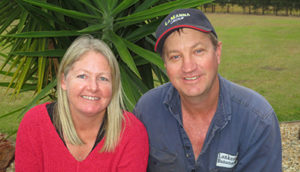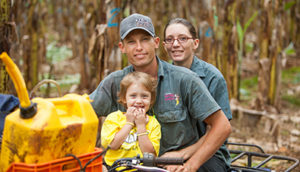Read the latest information on
Foot-and-mouth disease
 The owners of two businesses that grow bananas in north Queensland were finalists in the 2014 Plant Biosecurity Farmer of the Year Award.
The owners of two businesses that grow bananas in north Queensland were finalists in the 2014 Plant Biosecurity Farmer of the Year Award.
The greatest immediate disease threat to banana growers in north Queensland is Race 1 Panama disease (Fusarium oxysporum f.sp. cubense). But the biosecurity measures used on-farm to protect their businesses from this disease also prevent other pests and diseases, such as the more virulent Race 4 Panama disease.
Michael and Lisa Lankester from Walkamin on the Atherton Tablelands own and run Lankester Bananas, growing 60 hectares of Lady Finger bananas and 5 hectares (3650 trees) of trellised custard apples.
At the time the Lankesters purchased their new farm, Panama disease had just been detected on a commercial Lady Finger farm on the Atherton Tablelands.
“The greatest cost to the business would be losing what we had already invested to establish the farm, not the cost of implementing biosecurity practices,” said Mr Lankester.
 The other contenders for the award are Shannon Paton and Sarah Schultz, who run Paton’s Exotics at Nerada, near lnnisfail, growing seven varieties of bananas and sending the fruit to five states.
The other contenders for the award are Shannon Paton and Sarah Schultz, who run Paton’s Exotics at Nerada, near lnnisfail, growing seven varieties of bananas and sending the fruit to five states.
According to Mr Paton, knowing the pests and diseases of your crop and how they can spread – like soil, water and planting material – you can plan to prevent them from entering and becoming established on your farm.
“We did a fair bit of homework regarding our varieties and what diseases can knock them around,” said Mr Paton.
“Biosecurity measures start at the farm gate with washing vehicles, footwear and anything else that has soil on it or has come into contact with soil,” he said.